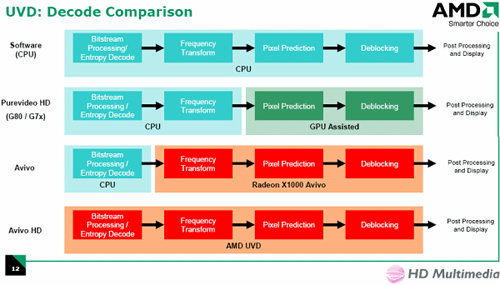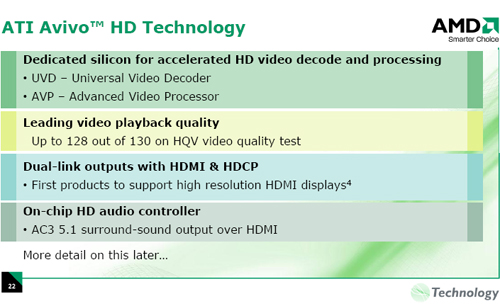Introduction
There has been a lot of talk over the past week about the fact that the Radeon HD 2900 XT lacks UVD (Universal Video Decode) hardware for HD video decode acceleration on the GPU. We've seen sites from The Tech Report to DailyTech, and even Beyond3D reporting on the situation. While there is much discussion already out there, we would like to provide our take on things.
To recap, the situation is as follows. A huge number of press and channel partners were given the impression by AMD that their R600 GPU used to build the new Radeon HD 2900 XT contained UVD hardware. AMD's press materials are incredibly vague about the issue: they never explicitly state that the HD 2900 XT does or does not physically have UVD hardware. They do list R600 as having AVIVO HD, which they explained includes GPU offload of the entire video decode pipeline in their press materials.

In other slides and presentations, AVIVO HD and UVD have been presented as synonymous. As the entire HD 2000 line is supposed to support AVIVO HD, how could we assume that UVD hardware wasn't included on the GPU?

It seems that AMD is now trying to make it clear that R600 (the 80nm GPU for the HD 2900 XT) does not include UVD, but supports the same video decode features as the X1950. Dedicated hardware makes a big difference in entropy decoding, as we've seen with our G86 testing, but neither NVIDIA nor AMD have top end parts with full spec video decode offloading. The rationale is that high-end GPUs will be paired with CPUs capable of decoding any HD video thrown at them.
With such a huge volume of information to absorb, it seems reasonable to think that some details could get lost in the mix. But, while AMD never actually said anything untrue, they did omit details which could have easily clarified the situation. Walk with us through our experience and see for yourselves how we came to our conclusions.
There has been a lot of talk over the past week about the fact that the Radeon HD 2900 XT lacks UVD (Universal Video Decode) hardware for HD video decode acceleration on the GPU. We've seen sites from The Tech Report to DailyTech, and even Beyond3D reporting on the situation. While there is much discussion already out there, we would like to provide our take on things.
To recap, the situation is as follows. A huge number of press and channel partners were given the impression by AMD that their R600 GPU used to build the new Radeon HD 2900 XT contained UVD hardware. AMD's press materials are incredibly vague about the issue: they never explicitly state that the HD 2900 XT does or does not physically have UVD hardware. They do list R600 as having AVIVO HD, which they explained includes GPU offload of the entire video decode pipeline in their press materials.

In other slides and presentations, AVIVO HD and UVD have been presented as synonymous. As the entire HD 2000 line is supposed to support AVIVO HD, how could we assume that UVD hardware wasn't included on the GPU?

It seems that AMD is now trying to make it clear that R600 (the 80nm GPU for the HD 2900 XT) does not include UVD, but supports the same video decode features as the X1950. Dedicated hardware makes a big difference in entropy decoding, as we've seen with our G86 testing, but neither NVIDIA nor AMD have top end parts with full spec video decode offloading. The rationale is that high-end GPUs will be paired with CPUs capable of decoding any HD video thrown at them.
With such a huge volume of information to absorb, it seems reasonable to think that some details could get lost in the mix. But, while AMD never actually said anything untrue, they did omit details which could have easily clarified the situation. Walk with us through our experience and see for yourselves how we came to our conclusions.










53 Comments
View All Comments
trisct - Tuesday, June 5, 2007 - link
The reason behind the UVD confusion seems fairly obvious. ATI was just purchased by a CPU company. The original design for the 2000 series GPUs almost certainly included UVD, it would have been an obvious weakness vs. NVIDIA, even if they only have full decode for one compression standard.The problem is that parent AMD is meddling with ATI's plans, and decided to do an about-face on the UVD component, in order to promote uses for multi-core CPUs. The marketing material was already done at that point, though, so everything got confusing. This is a clear internal conflict of interest, where on one hand AMD wants to sell high-end CPUs, and make them as useful as possible for as many tasks as possible, but also sell high-end GPUs, which in this instance compete directly with one of the main reasons to get a powerful multicore CPU. I hope this all doesn't boil down to ATI graphics going the Intel route and depending on the CPU more and more.
lemonadesoda - Wednesday, June 13, 2007 - link
Probably will.Anyone else get the impression that ATI is suffering major brand dilution. I have been a loyal ATI customer since 8500. My "loyalty" was partly due to driver simplicity (one driver pack for all machines)... but also because you knew-what-you-got and prices and performance was both competitive and leading edge.
I don't hold the same view anymore.
lopri - Tuesday, June 5, 2007 - link
Or take the job offer from NV. He won't be missed.Frumious1 - Tuesday, June 5, 2007 - link
Neither will your posts, if you'd care to STFU and get back to sniffing the AMD happy-shrooms.Khyron320 - Monday, June 4, 2007 - link
People are being way to harsh on this review. It is just good journalism they are reporting the facts here. Now if Nvidia is getting away with something similar and Anandtech is not reporting it then i would call them "anti-AMD". But as far as i know there they have not skipped on any anti-Nvidia news/reviews.lemonadesoda - Wednesday, June 13, 2007 - link
Good journalism = facts + issues + accurate + well writtenI supprt godd journalism. But his article scores a low 50%, and is not up to Mr. Wilsons usual standards. He can do better
DerekWilson - Sunday, July 22, 2007 - link
actually I appreciate the fact that you feel I can do better, and I agree that this was one of my weaker articles ... but I don't think what was said was unimportant or inaccurate ... companies need to be careful how the present details, especially when it can be so easily misconstrued by their partners (let alone journalists).TheOtherRizzo - Monday, June 4, 2007 - link
I think AT are absolutely correct in putting down AMD for this. But the question is why have these kind of things never been investigated before and why have AMD been singled out when Nvidia are just as guilty of lies concerning Purvideo. In case someone from AT is interested here is a quick list of issues to get you started:-Nvidia still [url=http://www.nvidia.com/page/purevideo_support.html">http://www.nvidia.com/page/purevideo_support.html]claims[/url] all sorts of Purevideo features for AGP cards when in fact they have been disabled in the driver for over a year now. Not even a task as basic as hardware deinterlacing works anymore (even my GeForce 3 could do that). This is a far more blatant lie than what AMD did with UVD.
-both AMD/ATI and Nvidia claim H264/VC-1 decoding when in fact they skip deblocking in most cases although deblocking is a non-optional part of the spec.
-both AMD/ATI and Nvidia announced hardware encoding years ago. AMD is still trying to be clever by offering a software only encoder that will only work if certain GPU's are present.
To find more information search doom9 and avsforums.
DerekWilson - Wednesday, June 6, 2007 - link
Thanks for the comments and the email ... Sorry I hadn't stepped in here and updated this thread earlier. I actually haven't been feeling well lately :-(Anyway, I just want you to know that we really do take your comments seriously and I'm looking into the issue. Here's a copy of the email I sent a couple NVIDIA PR and technical marketing contacts:
-----
-----
Hey guys,
In the wake of all the AMD Avivo HD confusion with their HD 2900 XT, I'm getting a lot of requests from users to look into other issues with improper reporting of feature support.
A number of readers have pointed me to this page:
http://www.nvidia.com/page/purevideo_support.html">http://www.nvidia.com/page/purevideo_support.html
These readers are saying that current drivers disable support for most (if not all) purevideo features in all AGP hardware, even with MPEG-2. I haven't tested this yet, and I'm not sure if I'll have the time this week. But I'd really appreciate it if you could get back to me with a statement about this.
If purevideo is currently disabled on AGP hardware, if the feature list is not accurate with current drivers, and if there are any plans to change this, can can you let me know?
I'm sure, with the current issues we're having with AMD, it goes without saying that accuracy and honesty would go a long way here.
Thanks,
Derek Wilson
7oby - Sunday, June 10, 2007 - link
Thanx, but I guess the question is too general to be answered by anyone at nvidia.
I just did a quick google to recall my last findings, but it's not complete nor did I always find the source of information.
WMV AGP Accleration seems to be enabled up to 78.01
http://forums.nvidia.com/lofiversion/index.php?t15...">http://forums.nvidia.com/lofiversion/index.php?t15...
Audio/Video sync issues seem to be the reason for disabling this Accel mode:
http://forums.nvidia.com/index.php?showtopic=12150...">http://forums.nvidia.com/index.php?show...p;mode=t...
There exists an additional theory that the AGP Bandwith is not sufficient for the way the work of the different accelerated decoding stages is distributed among CPU/GPU (German only):
http://www.computerbase.de/forum/showpost.php?p=10...">http://www.computerbase.de/forum/showpost.php?p=10...
About MPEG-2 and SSE related Stuff, I currently don't have any links.
When this topic was of more general interest other reviewers also did not get detailed information (Only German: Read the "update" part):
http://www.computerbase.de/news/hardware/grafikkar...">http://www.computerbase.de/news/hardwar...zember/b...
7oby